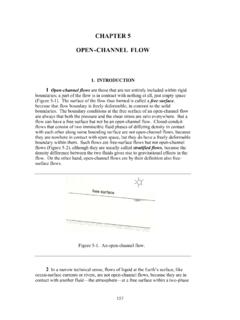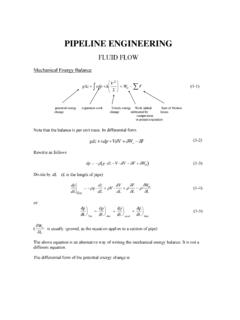Transcription of Viscosity and drag - Brock University
1 First name (print)last name (print)student numbergradeExperiment 5 Viscosity and dragDrag force arises when an objec t moves through a flu id or, equivalently, when fluid fl ows past an objec general, the drag force grows larger with increased fl ow velocity, bu t Viscosity is a complex ph enomenonthat cann ot be redu ce d to the simple relationship drag force is proportional to velocity .The origin of the drag forceFdli es in the nee d to displace the particles of the flu id out of the wayof a moving o bjec t. At low velocities the movement of the flu id is s moo th (laminar) and the faster theobjec t moves, the greater is the amoun t of flu id that has to g et out of the way, giving rise to the li nearrelationshipF(viscous)d=a vwherevis the velocity of the objec t relative to the flu id, is thecoefficient of Viscosity , andais the size of the objec t; for a sph ere of radiusr,a= 6 r.
2 The larger the size , the greater is the amoun t of flu id thatnee ds to g et out of the way, hence it is not surprising that t he relationship is li near with respec t t story gets far more c ompli cated for higher velocities, unu sual objec t shapes, of unu sual flu ids. Athigher velocities or aroundodd ly-shaped objec ts the flow stops being smoo th and turnsturbulent, whichrequires more e nergy and causes the drag force to switch to the quadratic regime, whereFd v2,F(inertial)d=S that t his express ion represents an inertial rather than a viscous force , and instead of the the Viscosity , , the flu id d ensity, 0, enters the the c ross -sec tional area o f the moving o bjec empirical parameter call ed the Reynolds nu mber determines which of the above two terms domi-nates.
3 R=d v where for a simple sph ere, the diameterd(= 2r) is the obvious defin ition of the size o f the particle1. ForR<1, the viscous drag dominates (and thu s there is no inertial coa sting), whil e forR>1000the viscousdrag is completely negli gible as compared to the inertial drag .At higher velocities s till, i n compress ible flu ids one nee ds to a cc oun t for the c ompress ion waves that getcreated ( the sonic boo m of a sup ersonic aircraft) , and in incompress ible flu ids the surface layer of theflu id may lose c ontact with the rapidly moving o bjec t creating local vacuu m ( cavitation on the surfaceof the blades of naval propell ers).
4 Unu sual flu ids s uch as s olutions of long polymers may experience flow indirec tions other than the direc tion of motion, as the e ntangled p olymer molec ules transmit t he movementof the objec t t o remote areas of the flu id and b ack. The flu id constrained into fin ite-size c hann els and tub es1 For other shapes, an equivalent hydrodynamic radius rhis used instead ofr4546 EXPE RIMENT 5. Viscosity AND DRAGF igure : Drag coefficient on a sph ere in an infin ite flu id, as a fun ction of the Reynolds nu mberalso behaves differently from an infin itely-broa d medium through which a small -size sph ere is traveli are c orr ec tions that must acc oun t for all of these detail convenient way to express just such a corr ec tion is through an empirical factor call ed the c oefficientof drag ,Cd, which can b e measured experimentall y and acc oun t for the detail s of shape, size , and thenature of the media through which an objec t is traveli ng.
5 This dimensionless coefficient is well -known andits tabu lated values can b e found in h andb oo ks. As a fun ction of the Reynolds nu mber, the e xperimentall ymeasured values of the drag coefficient,Cd, constitute the so-call ed stand ard d rag curve shown in Fig. a small sph ere traveli ng through an infin itely broa d flu id, thisCdprovides an exce ll ent ag ree ment withthe e xperimental drag force :Fd=KfCdS 0v22,Cd=Cd(R)( )The fin ite-size c orr ec tion coefficient,Kf, describes how this equation is modified b y the bound ary cond itionsof a flu id confin ed in a fin ite-size vess el. For a sph ere of diameterdtraveli ng a xiall y through a flu id chann el(a pipe) of diameterD, a dimensionless ratiox=d/Dcan b e used to a pp roximate this corr ec tion coefficientto within 6% via2Kf=11 x , = forx ,( )in the range of Reynolds nu mber values of 102<R< ft, , and les, Drop s, and Particles.
6 Academic Press , 197847 For an objec t at rest, there is no drag force . As we app ly a force to a n objec t, i t experience s anacce leration, i ts velocity grows, and with it grows the drag force that is direc ted opp osite the velocity. Thisdrag force c oun teracts the app li ed force and redu ce s the net force and the objec t s acce leration. Eventuall y,velocity increases to the point where the drag force is exactly matched to the app li ed force , bringing thenet force to ze ro. From this point on, the objec t is in equili brium, there is no a cce leration, and the velocityremains constant, equal to its s teady-state value c all edthe terminal ve locity, orvt.
7 For example, i f anobjec t is in a free fall through a flu id, this equili brium cond ition corr espond s to the weight of the objec texactly equal to the viscous force :Fd=W .When the flu id in question is a ga s s uch as air, the bu oyant forceFb equal to the weight of the displace dga s is tiny and can b e neglec ted. When the flu id is a more dense sub stance such as water, the aboveequation may nee d to be modified to includ e the bu ouyant corr ec tion due to the displace ment of the flu idby the objec tFd=W Fb=mobjec tg mflu idg=mobjec tg(1 0/ )( )where is the density of the material of the objec t and 0is the density of the flu id.
8 As you can see , onlythe ratio o f the two densities enters into the e xpresii on since the volumes of the objec t and of the flu id itdisplace s are the same. For example, for an Al ball i n water, 0= 103kg/ m3and = 103kg/ this experiment you will explore this relationship b y v arying the force and measuring the terminalvelocity of several sph eres of different size .Review questions What are the un its of the Viscosity coefficient ?.. What is the known value of for water at roo m temperature? Cite the source of your In terms of its diameterd, what are the c ross -sec tional areaSand the volumeVof a sph ere?
9 S=..V=.. For a sph ere of 1-cm radius moving through water at 1 m/s, calculate the Reynolds nu mberR. Whatare the dimensions ofR?..48 EXPE RIMENT 5. Viscosity AND DRAG For the above sph ere, which d rag force (inertial or viscous) dominates? What is the e xpec ted coeffi-cient of drag ,Cd?..CONGRATULATIONS! YOU ARE NOWREADY TO PROCEED WITH THE EXPERIMENT!Procedure andanalysisThe e xperimental app aratus consists of two different-size metal sph eres, a long cyli nd rical container fill edwith water, a pu ll ey system with a weight platform and variable weights, an u ltrasonic position sensor, adigital weight scale, a : The app aratus for measuring the drag force of the flu id on a moving sph ere Using a digital scale, weigh separately both sph eres and the weight platform.
10 You may also want t o49verify the e xact values of the various weights in the weight ..Wlarge=..Wplatform=..W 10 g =..W 20 g =..W 50 g =.. Using the micrometer, measure the diameterdof each sph ere and calculate their cross -sec tional areaS= d2 ..dlarge=..Ssmall=..Slarge=.. Measure and rec ord the inn er diameterDof the plastic c yli nd er fill ed with water. Verify that t hecross -sec tion is circular by measuring the diameter in a few different direc tions across the c yli nd the value of the parameterx=d/Dfor both sph Selec t one of the sph eres, adjust t he length of the string so that t he weight platform is at least 30 cmabove the ultrasonic detec tor at its lowest position, and a few cm below the pu ll ey at its highestposition (i.)








